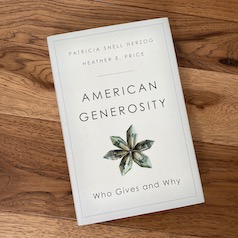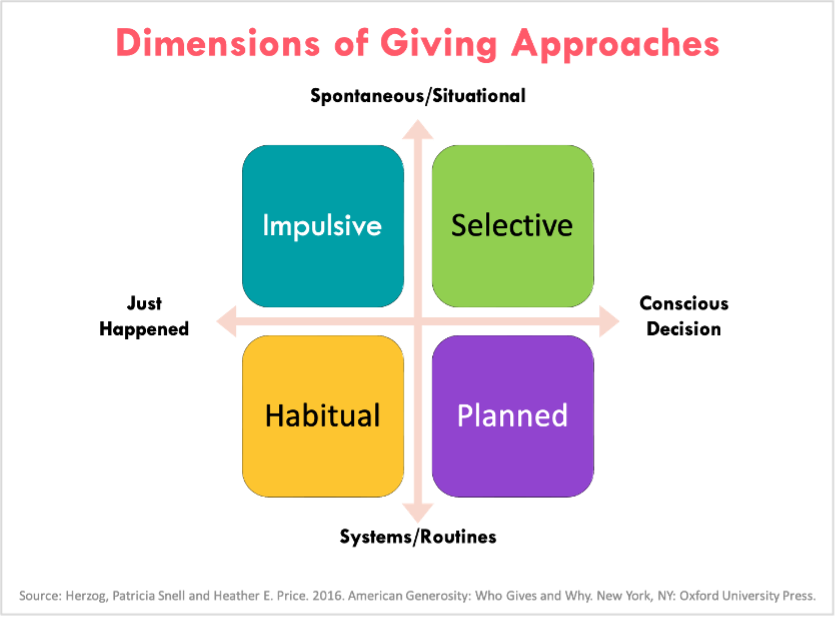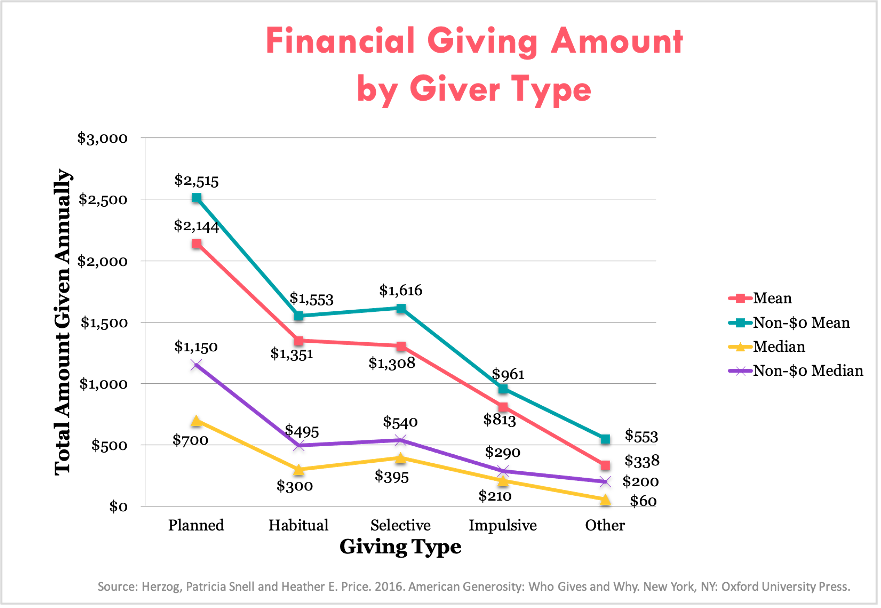Giver Types: A Fresh Perspective
Giver Types: A Fresh Perspective
This article is written by Patricia Snell Herzog, PhD. Dr. Herzog is the Melvin Simon Chair and associate professor of philanthropic studies in the Lilly Family School of Philanthropy at IUPUI, as well as affiliate faculty in the School of Informatics and Computing at IUPUI.
by Patricia Snell Herzog, PhD
In efforts to understand givers, there is what I think of as type hype. From popular media and blogs there is an array of psychology inspired personality types for givers. Some claim there are grudge givers, duty givers, and thanks givers. Others claim types include the flint, the sponge, and the honeycomb givers. Inverted, the classic personality type profile of the Myers-Briggs combination of ENFJ – extroverted, intuitive, feeling, and judgment – is commonly known as Type 2: The Giver. While there can be value in these approaches, as a sociologist I always find myself underwhelmed with a perspective that presumes people are fixed entities, with personality characteristics determining giving styles. This does not gel well with the social reality that people are more fluid that that, and shifting contexts matter.
From nonprofits and fundraising professionals, there is an array of economics-inspired donor segmentations. These are attempts to subgroup donor prospects based on their economic resources in combination with their social and demographic characteristics, such as age, education level, and geographical location. The idea is that nonprofits can personalize communication with donor segments in ways that tailor to each set of audience characteristics. There is a great deal of wisdom in this general approach, and many organizations find success. Yet, I again find my sociological imagination skeptical about how much donors truly identify with their demographic characteristics. The idea of tailoring to relevant audience sets is a good one, but the leap from demographic data to preferred form of communication is large.
Approaches to Giving
Amidst this type hype, here is a fresh perspective. The best way to tailor appeals is to engage donors based on the approach they take to their giving. How do people approach giving to charitable and religious causes? This was the question that my colleague Heather Price and I investigated in the third chapter of our book American Generosity: Who Gives and Why.
In our nationally representative survey, we asked two questions about giving approaches. The first focused on systems or routines for giving, as opposed to a more spontaneous or situational way of giving. The second inquired about a conscious decision to give, versus charitable giving having just happened. Both included options for non-givers.
Before you keep reading, I invite you to take a moment to answer these two questions for yourself. Read over the question, select a response, and jot down whether you are A1+B1, A1+B2, and so on. Then, you can find yourself in the giver types described below.
A. When it comes to voluntary financial giving, do you…
1. Follow systems or routines
2. More spontaneous or situational
3. Do not give money away
B. Have you ever…
1. Made a conscious decision to give more money away. Or has
2. Financial giving just happened
3. Do not give money for charitable, religious, or other causes
In the next section, look for your letter and number combinations at the end of each giver type description to see where your results place you.
Giver Types
Informed by a sociological tradition that embraces ideal types, we offer the following four categories that are based on the two dimensions asked about in those two survey questions. An important caveat here is that ideal in this sense does not refer to a desired or esteemed outcome. Instead, ideal in this context refers to the idea of an analytically clean category, derived from theories rather than the messier reality which is that people love to find ways to span boundaries.
In this context, I will walk you through the ideal typology. It is helpful to caveat that atypical givers remind us that social research never entirely goes according to plan by illustrating how people do not always fit nicely into one box or perfectly categorize into ideal types.
Excluding the roughly one in 10 Americans who selected A3+B3, which is a non-giver, the rest are donors. This figure shows four boxes formed by the intersection of two dimensions. From top to bottom, the first dimension is spontaneous/situational versus systems/routines. From left to right, the second dimension is just happened to conscious decision. The result is these giver types:
- Planned Givers: Follow systems or routines of giving and make conscious decisions to give more money away. About 16% of donors are Planned Givers. (A1+B1)
- Habitual Givers: Follow systems or routines of giving, yet also just happen to give. About 6% of donors are Habitual Givers. (A1+B2)
- Selective Givers: Make a conscious decision to give, yet also give spontaneously. About 17% of donors are Selective Givers. (A2+B1)
- Impulsive Givers: Are spontaneous or situational in their giving, which just happens. About 42% of donors are Impulsive Givers. (A2+B2)
- Atypical Givers: Identified as a non-giver for one question, but selected a giver approach for the second. About 19% of donors are Atypical Givers. (A3+B1,B2; B3+A1,A2)
Giver Type Appeals
Why do the giver types matter? I offer five answers to that. First, if you were to throw a proverbial stone in the U.S. you would be most likely to hit an Impulsive Giver. Second, since the largest donor type is impulsive, national averages best represent what is happening with this approach. Third, the figure below shows that average giving amounts stepwise by giver types. Planned and Habitual are the most likely to be givers in any given year. Planned and Selective are the most likely to give in greater amounts.
Fourth, Planned Givers are likely to have college degrees coupled with some religious attendance. Habitual Givers are likely to have high religiosity with lower income levels (these are the tithers). Selective are likely to have a college degree with infrequent religious attendance, and Impulsive a high income with low religiosity. Lastly, the implications are that Planned are most likely to desire an annual report, Habitual an infrequent reminder, Selective an explanation of the cause importance, and Impulsive a captivating and emotional appeal.
Questions for Reflection
-
- Take some time to figure out what type of giver you are based on the equation provided above. What did you learn about your giving type?
- How can you use this understanding of giver types to connect with your donors?
Expanded Perspective
Last year we invited Dr. Herzog to talk with our adjunct faculty about her book American Generosity and, specifically, types of givers. The video below is a clip from that presentation where she explains the different ways you can connect with the types of givers she wrote about in the article above.
American Generosity: Who Gives and Why
 American charitable giving veers from the hyperbolically generous to the hyperbolically stingy. On some days, no one has a quarter to spare; in times of disaster, Americans will put their lives on hold to build houses for those displaced by hurricanes. The crucial question of who gives and why they do it lies at the heart of American Generosity.
American charitable giving veers from the hyperbolically generous to the hyperbolically stingy. On some days, no one has a quarter to spare; in times of disaster, Americans will put their lives on hold to build houses for those displaced by hurricanes. The crucial question of who gives and why they do it lies at the heart of American Generosity.
Patricia Snell Herzog and Heather E. Price, sociologists who focus on philanthropy, draw on findings from the groundbreaking Science of Generosity initiative, which combines a nationally representative survey of adult Americans with in-depth interviews and case studies.
For most Americans, they find, the important forms of giving are: donating money, volunteering time, and taking political action. Focusing on these three types of activity, the authors go on to examine and analyze multiple dimensions of resources, social status, regional cultural norms, different approaches to giving, social-psychological orientation, and the relational contexts of generosity. Herzog and Price conclude that giving is supported by “circles of generosity,” which ripple outward in their reach to targets of giving. The book offers not just analysis, but practical tips for readers who want to increase their own giving, for parents modeling giving to their children, spouses desiring alignment in their giving, and friends and community members seeking to support giving by others. The authors also provide explicit fundraising ideas for nonprofits, foundations, and religious leaders.
A Few Spots Remaining
Our next online cohort of the Executive Certificate in Religious Fundraising starts soon and there are a few spots remaining! We surveyed our participants a year after taking the course and one wrote that through ECRF they gained “confidence, direction as an executive fund raiser, ability to engage in fundraising conversations from a faith-based perspective.” Another wrote that they gained “a confidence that I can be a part of these discussions despite the fact that I don’t have unlimited means.” Wherever you find yourself on this spectrum, we are confident that you will gain the skills and tools you need to grow as a religious fundraiser!
Register today
Subscribe
Insights is a bi-weekly e-newsletter for the religious community and fundraisers of faith-based organizations that provides:
- Reflections on important developments in the field of faith and giving
- Recommended books, studies and articles
- Upcoming Lake Institute events




